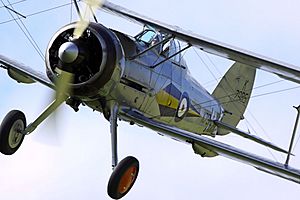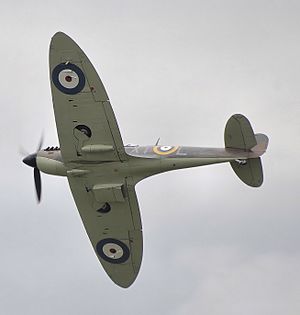William Henry Franklin facts for kids
Quick facts for kids
William Henry Franklin
|
|
|---|---|
| Birth name | William Henry Franklin |
| Nickname(s) | Bill |
| Born | 2 October 1911 Mile End, London, England |
| Died | 12 December 1940 (aged 29) English Channel, off Selsey, Sussex, England |
| Memorial | |
| Allegiance | United Kingdom |
| Service/ |
Royal Air Force |
| Years of service | 1928-1940 |
| Rank | Pilot Officer |
| Service number | 562984 (airman) 44753 (officer) |
| Unit | No. 65 Squadron RAF |
| Battles/wars | Second World War
|
| Awards | Distinguished Flying Medal & Bar |
| Relations | Louise Eliza Kogel (married March 1937) |
William Henry Franklin (born October 2, 1911 – died December 12, 1940) was a brave Royal Air Force pilot. People also knew him as Bill Franklin. He was a famous flying ace during the Second World War. This means he shot down many enemy aircraft. Bill was honored twice for his bravery. He took down more than 13 enemy planes. This happened during the Dunkirk evacuation and the Battle of Britain. Sadly, he was killed while flying in action.
Contents
Early Life of William Franklin
William Franklin was born in Mile End, London, England. His birthday was October 2, 1911. His parents were Harriett Amelia and George Franklin. George worked with wires. Sadly, William's father died in France in 1917. William went to Thomas Street Central School.
Joining the Royal Air Force

In January 1929, Franklin joined the Royal Air Force (RAF). He started as an aircraft apprentice. He learned to fix airplane engines. In December 1931, he finished his training.
After working on planes, he wanted to fly them. He was accepted for flight training. By the early 1930s, he became a pilot. He was promoted to sergeant. In March 1937, he married Louise Eliza Kogel in London.
Soon after, he joined 65 Squadron at RAF Hornchurch. He flew Gloster Gladiator fighter planes. Other pilots there became famous flying aces too. In March 1939, his squadron got new planes. They started flying Supermarine Spitfire Mark I aircraft. When the war began in September 1939, Franklin was an experienced pilot. He was still with 65 Squadron.
Battles in France and Dunkirk
No. 65 Squadron RAF started fighting in May 1940. This was during the Battle of France. Franklin quickly had several successes.
- On May 22, 1940, he helped damage a Junkers Ju 88 bomber.
- On May 24, he helped destroy a Henschel Hs 126 plane. It crashed in flames.
- On May 26, he destroyed a Messerschmitt Bf 109 fighter. He also destroyed a Messerschmitt Bf 110 twin-engine fighter.
- On May 27, he destroyed a Junkers Ju 88 bomber. He also helped destroy a Dornier Do 17 bomber.
- His last success then was on May 28. He helped destroy another Dornier Do 17 over Dunkirk.
On June 25, 1940, he shot down two more Messerschmitt Bf 109 fighters. These were over Abbeville. For his bravery, Franklin received the Distinguished Flying Medal on July 9, 1940.
The Battle of Britain

On July 7, 1940, he claimed two Messerschmitt Bf 109 fighters. These were near Dover and Folkestone. The next day, he claimed another Bf 109 near Dover. On July 25, 1940, he forced another Bf 109 down into the English Channel.
On August 5, 1940, he shot down two more Bf 109 fighters. He also claimed a third one as damaged. On August 16, 1940, Franklin fought Luftwaffe planes near Deal. He shot down a Bf 109 and damaged a Dornier Do 17.
Because of his continued bravery, Franklin received a Bar to his Distinguished Flying Medal. This was awarded on August 13, 1940. This means he got the medal a second time.
On August 20, 1940, he was sent to RAF Hornchurch for a short time due to sickness. He returned to 65 Squadron on October 13, 1940. On this day, he was also promoted to pilot officer.
His Final Flight
On December 12, 1940, William Franklin was flying his Supermarine Spitfire. He was part of 65 Squadron. They spotted a German Junkers Ju 88 plane over the sea. This was near Selsey.
The German plane's gunners fired back. Their shots were very accurate. They hit two British fighters. One of the planes shot down was flown by Pilot Officer Merrick Hine, who died. Franklin's plane, Spitfire R6982, also did not return from this mission. He was lost at sea.
Awards and Recognition
William Henry Franklin received two important awards for his bravery:
- Distinguished Flying Medal
* Awarded on July 9, 1940. * He was recognized for his actions in May and June 1940. He took part in many patrols and fought the enemy often. He shot down several enemy planes by himself and with his team. He showed great skill and courage. He would chase enemy planes for miles to destroy them.
- Bar to the Distinguished Flying Medal
* Awarded on August 13, 1940. * This was for his continued success since May 22, 1940. He shot down ten more enemy aircraft and helped destroy two others. On two occasions, he shot down two Messerschmitt 109s in one flight. His skill and bravery were considered outstanding.
See also
- List of World War II flying aces

